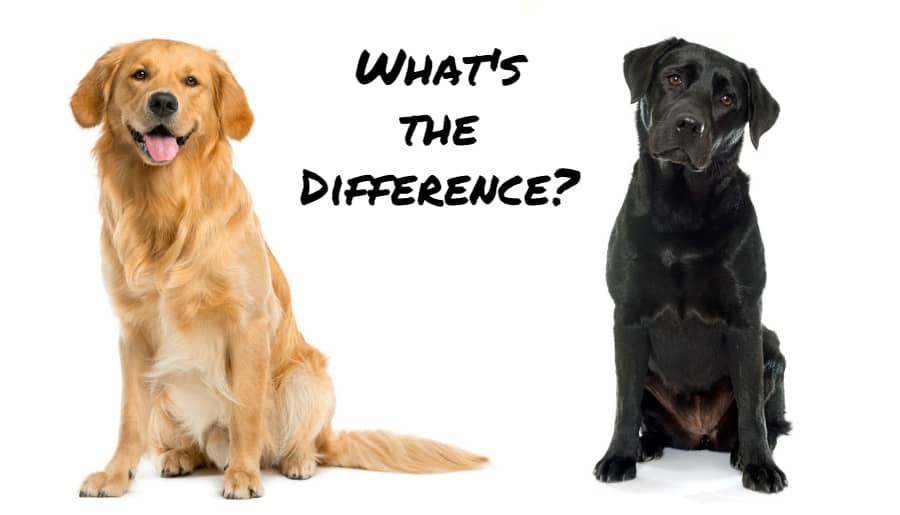
It’s amazing just how many people are unable to tell the difference between the Golden Retriever and the Labrador Retriever. As near as I can tell, this confusion stems completely from the similarity in their names, since there are a number of clear differences between these two types of dog. However, with a little education, it becomes far easier to differentiate one from the other.
So, What’s The Difference Between a Golden Retriever And a Labrador Retriever? The simple answer is that there are many differences. These include coat length, hair type, body length, behavior, activity level, and more. These are two very different breeds.
Breaking It Down One Quality At A Time:
Of course, we aren’t going to stop with a simple answer like that. In the interest of putting this old and (mostly) false association to bed, we have prepared a detailed comparison of these two breeds. Keep reading, and educate yourself!
Origins:
Origins of the Labrador Retriever:
As we have already discussed in previous articles, the Labrador Retriever is a descendant of the St. John’s Water Dog, a Canadian breed from Newfoundland that went extinct in the 1980s. The Labrador shows its connection to this extinct breed with its extreme affinity for water.
Aside from this, both breeds fulfill the same purpose. Like its ancestor, the Labrador was primarily developed for hunting game birds. For most of its history, the Labrador has been extremely popular among hunters of waterfowl.
The breed is named for the region in northeastern Canada where they were first produced. The earliest known records of the Labrador’s existence dates back to 1814 and is contained in a book titled “Instructions To Young Sportsmen,” written by one Colonel Peter Hawker. We can see that the Lab has been a hunter’s dog right from the beginning.
Origins of the Golden Retriever:
The origins of the Golden Retriever go back to mid-19th century Scotland. Scottish hunters, at that time, were looking for a new type of hunting dog.
The Retriever breeds that were common in those days were inadequate to the particular environment of Scotland. Much of the best hunting area consists of highland forests and marshy ponds. Thus, you need a dog that is able to hunt on land or water. To achieve this, they began breeding existing Retriever breeds with Tweed Water Spaniels. By crossing a land Retriever with a water Retriever, they sought to create the ultimate hunting dog. This crossing with Water Spaniels is the reason for the longer coat of the Golden Retriever.
It should be noted that there is a false story floating around on the internet concerning the origins of the Golden Retriever. Some people are saying that the original crossing (of Retrievers with Water Spaniels, that is) resulted in the creation of three other breeds apart from the Golden Retriever.
Those three are the Irish Setter, the Bloodhound, and the St. John’s Water Dog. That last one is a problem because the St. John’s Water Dog is known to have existed at least since the 17th century, well before the Scottish game hunters of the 18th century created the Golden Retriever.
Height:
In height, both of these Retriever breeds are quite similar. According to the AKC’s guidelines, a dog must fall within a certain height range in order to be certified as pure-blooded.
- Labradors Retrivers: 22.5 inches-24.5 inches for males and 21.5 inches-23.5 inches for females.
- Golden Retrievers: 23 inches-24 inches for males and 21.5 inches-22.5 inches for females.
We can see that these numbers are almost identical. The largest difference (in the upper height limits of the females) amounts to one inch. If we were looking at height alone, these dogs would only differ by an inch or less. It should be noted that the AKC will allow a variation of 0.5 inches or less.
Weight:
As you might well expect, the AKC and other kennel clubs also have requirements regarding weight. In this department, our two Retriever breeds also come out looking very similar. The accepted weight range:
- Labrador Retrievers: 65 pounds-80 pounds for males and 55 pounds-70 pounds for females.
- Golden Retrievers: 65 pounds-75 pounds for males and 55 pounds-65 pounds for females.
As you can see, these animals will only differ in weight by a maximum of five pounds.
Body Length:
Kennel clubs seem to be far less picky about a dog’s body length, so this information is a little harder to come by. So, we must dig a little deeper and look at the full AKC standards for this breed. Here are the stats for the Goldie and here are the stats for the Lab.
What we see here are not exact numbers, but just a general requirement that the length of the dog should be only slightly longer than the height of the dog, measured at the withers. If you aren’t familiar with the term “withers,” it denotes the top of the shoulder blades. Anyway, this requirement is the same for both Labs and Goldies.
Coat and Tail:
We can see a much larger difference when we look at the coats and tails of these animals. First of all, let’s consider the obvious. Golden Retrievers have much longer hair than Labrador Retrievers. As we already know, this is the result of their mixture with long-haired Water Spaniels.
Looking at pictures of the Tweed Water Spaniel (now extinct) we can see that the breed was highly prized for its skill in waterfowling. We can also see that it has a thick and shaggy coat. Its closest living relative, the Curly Coated Retriever, also has such a coat.
Both of our Retrievers have a coat that naturally repels water, but the Goldie also has a dense inner coat that protects it thoroughly from the cold.
The Labrador relies a little more on their outer folds of skin, which serve as an insulating layer.
The Golden Retriever also has a wavy coat, as opposed to the short, straight-haired coat of the Lab. In practice, this means that the Goldie will be warmer in the winter, while the Lab will probably be able to swim faster.
When it comes to the tail, the Labrador stands out from the Goldie because of their beaver-like “paddle tail.” Their tail is slightly flattened, unlike the rounded tails of most dogs. This allows them to swim with their tail in a manner similar to that of a beaver. That’s right; your Lab has a beaver tail or at least the closest canine equivalent. As far as I can tell, the Golden Retriever does not have this feature.
Usefulness:
In this department, it is hard to find much difference. Despite their differences in bloodline and physical characteristics, these two breeds are used for the same purposes. Both are hunting dogs that specialize in retrieving waterfowl. Both have been used for these purposes throughout their entire history. Personally, I think of the Goldie as a cold-weather Retriever, while the Lab is a warm-weather Retriever.
Behavior:
Having been used for the same purposes for so long, Goldies and Labs are also similar in temperament. However, they are still noticeably different. For starters, let’s look at aggression.
The Labrador is not just famous for fetching ducks. It is also well-known as a gentle and friendly family dog. Looking back at the AKC requirements presented above, we can see that a stable and friendly temperament is something of a requirement for this breed.
The Golden Retriever is also a good family dog but might be a little more likely to bite or to show territorial behavior. This is not necessarily a bad thing if you’re looking for a protection dog, but it can become a huge problem if it turns into uncontrolled aggression.
However, the aggression difference is not a big one. There are actually good statistics that we can use to determine the approximate aggression level of a particular breed. These statistics come from the American Temperament Test Society (ATTS) and can be viewed on their website.
The ATTS has developed a series of tests that are designed to measure the relative aggression level of any dog breed. Instead of giving test scores, it is a simple of passing or failing. Thus, we can measure aggression by looking at the pass-fail rate for any listed breed.
The pass rate for Golden Retrievers is 85.6%, which is definitely good. However, the Labrador blows them out of the water with a pass rate of 92.2%.
It should be remembered that these numbers are based only on the number of dogs who have come in for the test. It stands to reason that the most aggressive dogs would probably not be taken in for testing since their owners already know that they are aggressive. You don’t need a test to tell you what you already know! It also stands to reason that the mildest and most obedient dogs will also be less likely to be tested.
While we’re talking about dog aggression, let’s see which breeds show the lowest pass rate. Most people would guess that the most aggressive dogs would be Rottweilers, Pit Bulls, Dobermans, and maybe German Shepherds. However, the test results do not show this to be true. Here are their pass rates:
- Rottweilers: 84.7%
- Pit Bulls: 87.4%
- American Staffordshire Terriers (
close relative of the Pit Bull): 85.5% - Doberman Pinschers: 79.5%
- German Shepherds: 85.3%
So, which breeds rate the lowest? Let’s take a quick look:
- Alaskan Klee Kai: 50%
- Bearded Collie: 56%
- Czechoslovakian Vlczak: 50%
- Mudi: 40%
- Polish Sheepdog: 54.5%
Podongo : 50%- Skye Terrier: 37.5%
- Tibetan Mastiff: 52.9%
That last one is pretty scary, considering that the Tibetan Mastiff is the world’s largest breed of dog. Anyway, getting back to the point, the Golden Retriever might be slightly more aggressive than the Lab, but the difference probably isn’t that great in practice.
There is a slight difference between Labs and Goldies in the discipline department as well.
Labradors tend to respond well to a firm hand. This does not mean that you should be overly harsh with them, but their stubborn and rambunctious nature makes it imperative that you get a good handle on any behavioral problems and deal with them decisively.
A Golden Retriever seems more likely to lower their head and roll over when subjected to discipline and is quicker to whine when they know their master is displeased. This inherent drive to please their master is one of the reasons for the popularity of the Golden Retriever. It is also the reason that they do not respond well to negative reinforcement.
But what about obedience? We have spent all this time talking about aggression, but obedience is every bit as important. However, this is a quality that can be hard to measure. As with aggression, a lot of it depends on how you raise your dog, and how well you acclimate them to other humans and other animals.
The owner, in my experience, has just as much to do with temperament as does breed. Don’t get me wrong, breeding plays a big role in dog behavior, but proper training and rearing are just as important. Some trainers may differ in this opinion, but I will stick to the evidence of my own experience on this one and I advise you to do the same.
To measure obedience, let’s again turn to our respected friends at the AKC and look at the results of their most recent obedience competition. That’s right, they actually have contests in canine obedience.
When we look at the results, we can see that five Labrador Retrievers went home with prizes that day (June 2018, if you are curious). This may seem impressive, but the Golden Retrievers racked up an amazing 23 wins!
Based on these results, it is clear that the Golden Retriever is more obedient, at least on average. This kind of makes sense because the Lab has a reputation for being somewhat stubborn at times.
Activity Level:
Now we’re back into similar territory again. In terms of their activity level, both of our Retriever breeds are known for their high energy level and their dedication to finishing whatever task they are doing.
With both breeds, owners are often cautioned to avoid overworking them, because they will literally work until they drop. This is one of the reasons that Retrievers make such good search and rescue dogs.
Subtypes:
Like most species of dog, these two Retriever breeds show a little bit of variance from one place to another.
However, the two breeds are a little different in terms of those variations. The biggest difference is that Labradors only have three basic forms: The yellow lab, the chocolate lab, and the black lab. Color is the main variance between the different subtypes of Labrador Retriever.
While there are specific bloodlines that have been created for specific purposes, they are basically just variations of the three basic types. However, it is true that there are distinct differences between Labradors bred for show and Labs that were bred for work.
Show Labs tend to have broader heads and necks, as well as shorter muzzles. Field labs are on the other end of the spectrum, having longer muzzles, smaller heads, and longer legs. These differences are a frequent source of debate among Labrador enthusiasts.
The Golden Retrievers are generally divided by region of origin rather than by color. Obviously, a Golden Retriever in any other color would be silly, so all of them have more or less the same color.
The first Golden Retrievers were bred in Scotland, as you already know, and the modern descendants of the first Golden Retrievers are what they call the “British” Golden Retrievers. I think that’s kind of offensive to the Scots, but what do I know?
The British Goldies are broader and more muscular than the others (as a general rule) and are normally very light in color. This subtype can also be distinguished by its rounded eyes.
The American Golden Retriever tends to be a little lankier and taller, but this is not an absolute rule. The American Goldie tends to have thicker fur that lacks the long, wavy nature of the British subtype.
There has been a lot of cross-breeding between the British and American lines, making it hard to tell them apart at times.
The Canadian Golden Retriever stands out a little bit from the others due to its slightly darker coat and superior height.
Related Questions:
Can Golden Retrievers and Labrador Retrievers do all the same things?
Yes. These two breeds are similar enough to assume that they can do all the same tasks and activities. However, there are some slight differences in their tendencies.
Is a Golden Retriever More Likely To Bite?
Statistics indicate that this may be the case, but it is far from a closed case. In general, the Golden Retriever is known to be a calm type of dog, but certain individuals have been known to show aggression, as with any breed of dog.
What are the most obvious physical differences between Labradors and Golden Retrievers?
The two most distinctive features of these breeds would be the long hair of the Golden Retriever, and the flat, paddle-like tail of the Labrador. Thus, it is easy to tell them apart.



